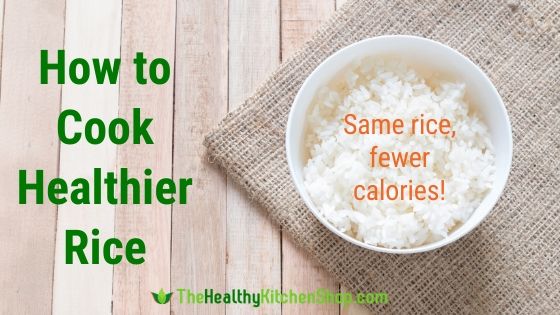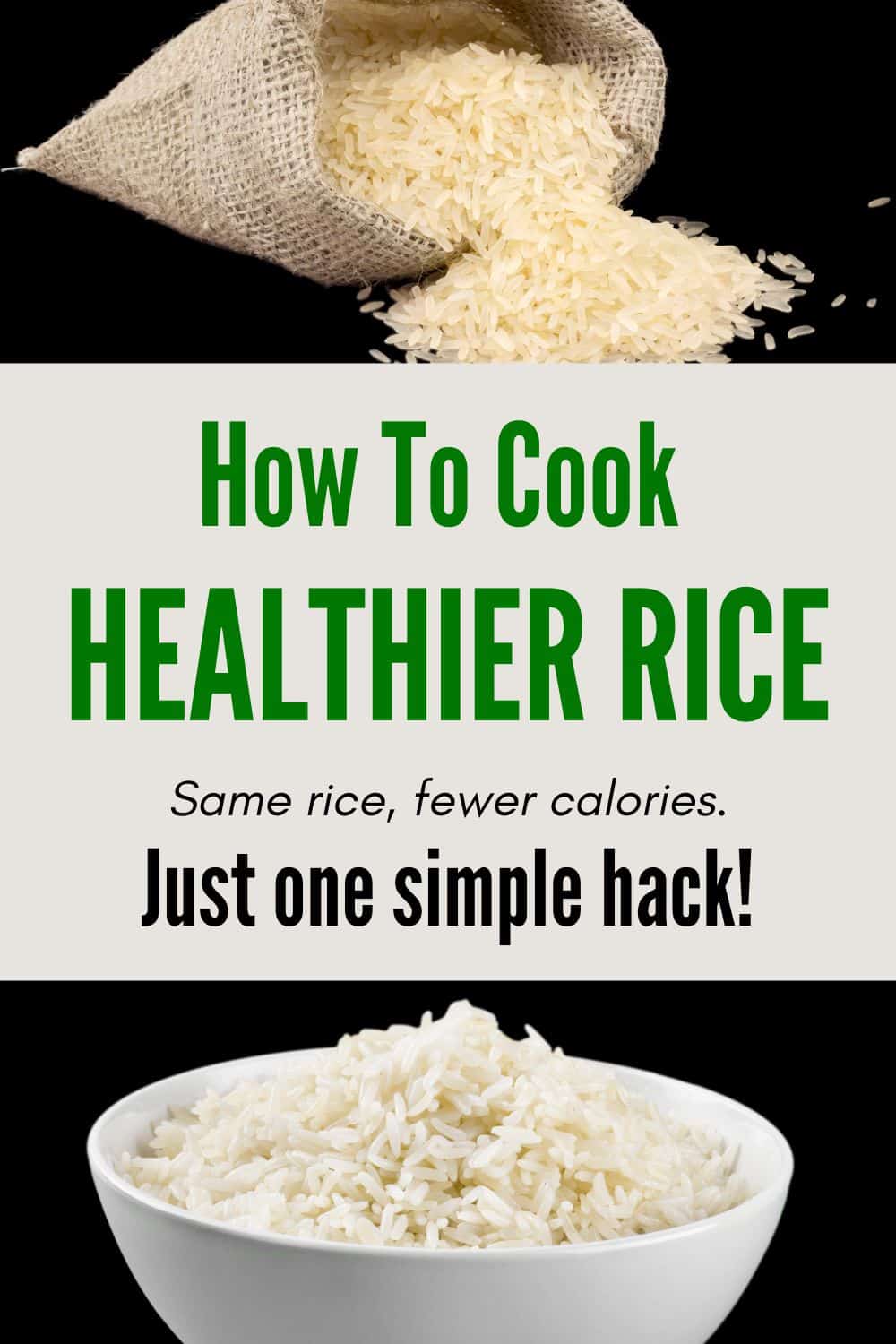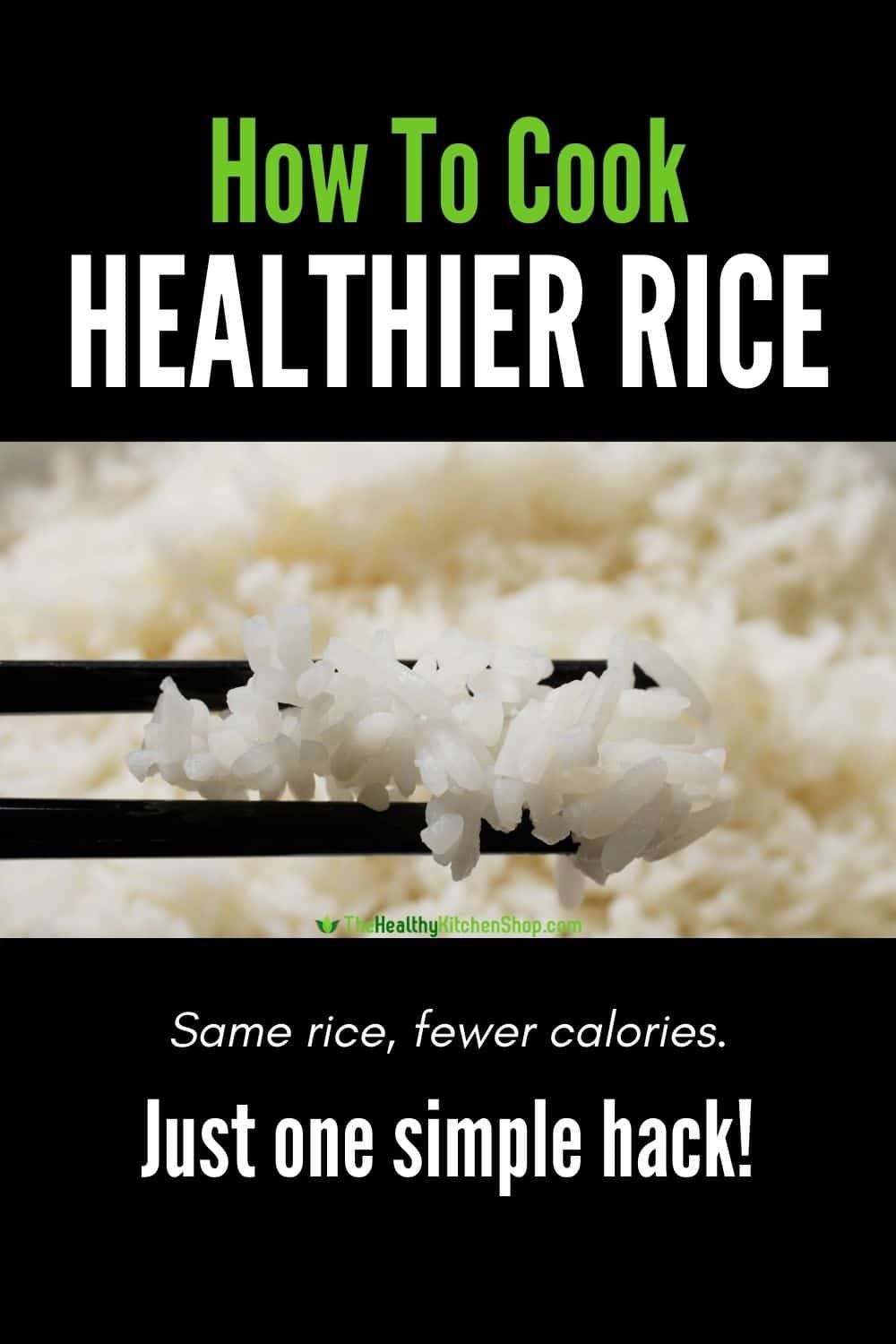The key to how to cook healthier rice is in the cooking method. Use this one simple trick to reduce the calories in plain white rice by 10 to 12 percent – and even more with healthier rice varieties!

Plain white rice has always been one of my favorite foods. There are endless ways to enjoy it – in casseroles, for a breakfast cereal, as a side for Asian food or Mexican food or pretty much any other main dish on earth, or of course served up with good ole high-fat-unhealthy southern brown gravy.
Besides that, rice can be a great help when your grocery budget is shot because it’s so incredibly cheap and filling too.
Unfortunately, I discovered long ago that eating rice makes me pack on the pounds faster than most any other starchy food. That’s true even without the gravy or other high calorie accompaniments. For me, the culprit is the rice itself.
Then I discovered this fascinating news that was reported by the Washington Post back in 2015.
There is a Simple Way to Cook Rice That Will Reduce Its Calories!
The Easy Method for Cooking Healthier Rice
What it boils down to, pardon the pun, is ultra easy:
- Prepare rice as usual by first bringing your water to a boil.
- Before you add the raw rice, add coconut oil (amount explained below *).
- As soon as rice is cooked, place in refrigerator to cool for about 12 hours.
That’s it. If there is any “catch”, it’s that you have to plan ahead because the cooling period is important. To my mind the payoff is well worth it because you still get the taste you love, and you can eat the same portion size but consume fewer calories.
* The recommended amount of coconut oil is approximately 3% of the weight of the rice you are cooking. Here’s the math for 1 cup of rice:
- 1 cup of rice weighs about 180 grams or 6.35 ounces.
- 3% of 180 grams is 5.4 grams.
3% of 6.35 ounces is .19 ounces. - 5.4 grams of coconut oil is equal to approximately 1 1/4 teaspoons of coconut oil.
.19 ounces of coconut oil is equal to approximately 1 1/4 teaspoons of coconut oil.
So, for 1 cup of rice, you need to use 1 1/4 teaspoons of coconut oil.
To do your own conversions use an online tool such as this one.

How It Works
The original article goes into great detail, but in basic terms it’s a matter of chemistry. All starches are not the same. Some are easy to digest and quickly turn into glucose, and then into glycogen, and these are the kinds of starches that make us pile on weight.
There are also starches that are termed “resistant”. Resistant starches don’t add so many pounds so fast because they’re hard to digest and therefore can’t be quickly converted into glucose.
Scientists have been studying the possibility of preparing food in a way that will change the type of starch in it, and that’s what cooking method described above does. Both the coconut oil and the cooling period work to actually change the composition of the rice. The amount of easily digestible starch in the rice is reduced, which reduces the calories in it.
Your Rice Calorie Mileage May Vary
The calorie savings on ordinary white rice is around 10% to 12%. So far testing has been limited, but the expectation is that using healthier varieties of rice will result in a 50% to 60% calorie reduction.
To date, scientists believe the best results will be with Suduru Samba, a variety of rice grown in Sri Lanka and parts of India. It’s rather pricey and can be difficult to find. Sometimes it is available on Amazon. (Click the image below to see current availability and price on Amazon. If not, this page may suggest a different brand.)

While a calorie savings of 10% might not sound that thrilling, it can make a big difference for some of us. One of the best ways to maintain weight or even shed a few pounds over the long term is to cut back just a little.
For instance if you love milk and drink a 12 oz. glass every day, you can cut back to a 6 oz. glass without being deprived and enjoy some calorie savings at the same time. This certainly won’t make you drop pounds overnight, but what it will do is create a new, lower calorie habit that has longer term benefits. Granted, that isn’t nearly as exciting as dropping 5 pounds in a week. But then, in my experience it’s much easier to keep weight off when you lose it slowly.
The other good news is that this research may eventually help us with more than just rice. We already know that the processes of heating and cooling can cause chemical changes in the foods we cook. With more research, scientists might soon discover ways to make lots of other favorite dishes a little less fattening and a little more healthy.
Just think, a way to save on calories without any sacrifice. It doesn’t get better than that!
You might also like:
Weight Watchers Air Fryer Recipes
Portion Control for Eating Healthy
Best Cookbooks for Healthy Eating – The Top 5 for Busy People
If you found this info helpful please share on Pinterest and help us spread the word!



Leave a Reply